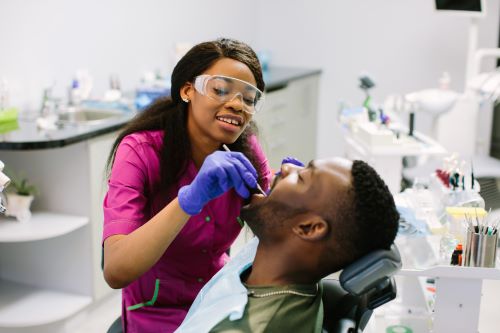Enter your email to receive the CareQuest newsletter:
August 9, 2022
Racism is a public health epidemic. Across the US, there are barriers to care that have blocked people of color from receiving adequate health care for years. Lack of economic opportunity, lack of access to insurance, lack of affordable care, lack of representation in the medical field, implicit bias, and stereotyping are only a few examples of barriers that we have to work to break down.
So, what can we do? How can we move forward?
A roundtable of oral health leaders came together to discuss those questions at a recent CareQuest Institute webinar, “Taking Action to Advance Anti-Racism in Dental Public Health.” The webinar focused on a special issue in the Journal of Public Health Dentistry on the topic.
“We must work broadly toward eliminating the existing structures and policies that perpetuate systemic racism and white supremacy. However, we cannot operate in isolation,” said Eleanor Fleming, PhD, DDS, MPH, FICD, assistant dean for equity, diversity, and inclusion at University of Maryland School of Dentistry on the webinar. “We, as a collective dental public health community, must promote the best scientific information; support efforts to improve equity, diversity, inclusion, and belonging within dental education; advocate for anti-racist policies; and encourage practices that advance health equity.”
Dr. Fleming moderated the panel that included Pamela Alston, DDS, MPP, FACD, immediate past president, National Dental Association, and founding director, Diverse Dental Society; Patrick Smith, DMD, MPH, assistant professor, University of Illinois, Chicago College of Dentistry; and Jill Boylston Herndon, PhD, managing member and principal consultant, Key Analytics and Consulting, LLC. Each participant began the webinar with an overview of their article that appeared in the publication.
 “One of the things that we have to acknowledge in conversations about racism is that for Black men racism is gendered . . . [so what] we really wanted to do with our piece in the special issue of the Journal was to highlight exactly how those experiences are gendered,” said Dr. Smith, when introducing the topic of his article. “What steps are we taking in order to get to a point where we can realistically start to address the issues of race and racism for Black men and to continue to promote oral health?”
“One of the things that we have to acknowledge in conversations about racism is that for Black men racism is gendered . . . [so what] we really wanted to do with our piece in the special issue of the Journal was to highlight exactly how those experiences are gendered,” said Dr. Smith, when introducing the topic of his article. “What steps are we taking in order to get to a point where we can realistically start to address the issues of race and racism for Black men and to continue to promote oral health?”
Dr. Boylston discussed her work researching disparities in health care quality for children enrolled in Medicaid and CHIP and the importance of data collection.
“Right off the bat, we found that two-thirds of state Medicaid programs are missing at least 10% of race and ethnicity data, and half are missing recent ethnicity data on more than 20% of their beneficiaries,” she said. “Documenting disparities is really only a first step, and it's a critical step. Lack of data means lack of ability to identify which populations have the biggest care gaps, disparities, and inequities that otherwise remain hidden.”
From there, the experts engaged in a roundtable discussion that brought in several questions from the more than 300 oral health stakeholders who joined the webinar. Making progress and taking actions to advance anti-racism were top of mind for everyone.
Seven Actions to Advance Anti-Racism
In a post-webinar survey, we asked participants what actions they planned to take after the discussion. We summarized some of the responses below — and invite any readers to take these actions, too:
- Increase education. Organizing classes that deal with racism and inclusion. Encourage more people to participate in Diversity, Equity, and Inclusion CE courses.
- Have open-minded discussion. Advance understanding of racial equity among staff and share anti-racism concepts. Open the discussion about the health disparities that racism can foster.
- Share resources. Share resources like this webinar recording, the Journal of Public Health Dentistry, and the anti-racism in public health white paper with my team members.
- Participate in trainings. Do staff-wide training about unconscious biases and managing their own racist behaviors. Recognizing institutional bias in our hiring and doing training to combat it.
- Collect more (and better) data. Support efforts to collect demographic information as a first step in measuring whether inclusivity efforts are succeeding. Not using “normal” standards, which are typically geared toward a traditional white population, as the comparison for marginalized groups.
- Partner. Partner with colleagues who are focusing on health equity to ensure that dental needs of the marginalized community members are included in their work.
- Invest with purpose. Support BIPOC communities by funding grants that express the dire need to address racial disparities in oral health. '
Editor’s Note: You can watch the full recording of the webinar and roundtable discussion in the CareQuest Institute webinar library.